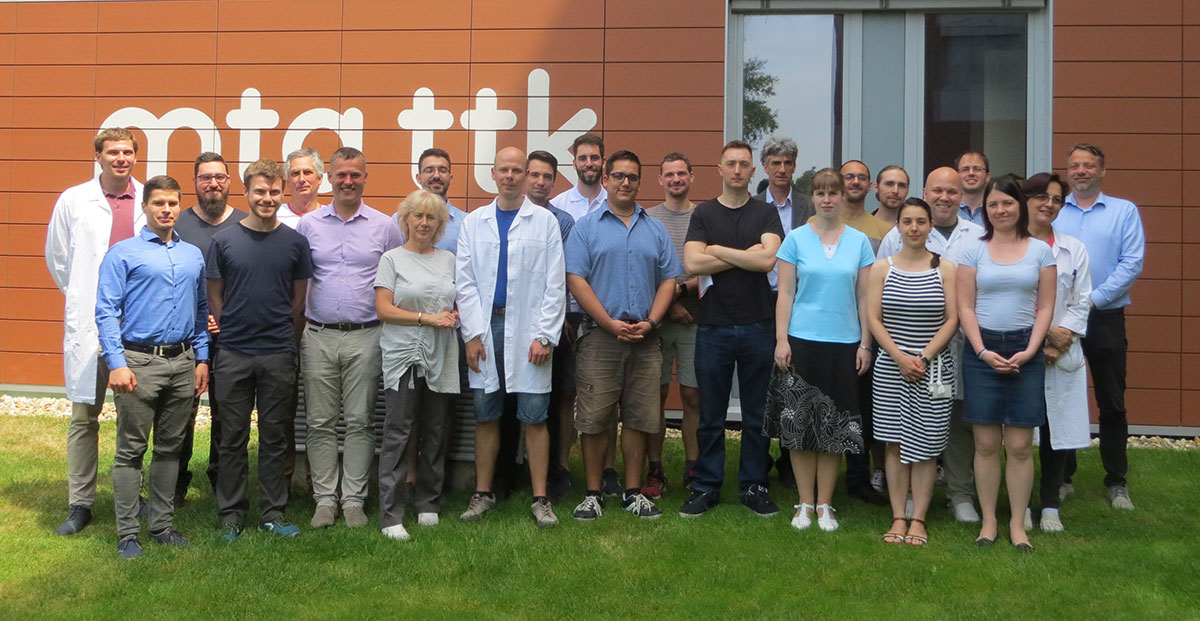Website
Research interest
Fragment based approaches in the lead discovery of GPCR and kinase targets. Chemical process development for small molecule active pharmaceutical ingredients. Synthesis and reaction mechanisms of heterocyclic organic compounds.
Current research projects
- Computer-aided design and synthesis of novel STAT inhibitors.
- Fragment-based drug design and synthesis for CNS (Central Nervous System) targets.
- Fragment-based design and synthesis of covalently binding ligands against relevant drug targets.
- Study of synthesis, reactivity, and ring transformations of heterocycles with zwitterionic structures.
- Synthesis of new angularly and linearly fused heteroaromatic ring systems.
- Studies on synthetic methods involving generation of nucleophilic carbene intermediates.
- Synthesis of new intercalating agents and multi-drug-resistance-decreasing compounds.
Selected recent publications
Full, current list on our website: http://medchem.ttk.hu/
Susanne Prokop, Péter Ábrányi-Balogh, Benjámin Barti, Márton Vámosi, Miklós Zöldi, László Barna, Gabriella M. Urbán, András Dávid Tóth, Barna Dudok, Attila Egyed, Hui Deng, Gian Marco Leggio, László Hunyady, Mario van der Stelt, György M. Keserű, István Katona, PharmacoSTORM nanoscale pharmacology reveals cariprazine binding on Islands of Calleja granule cells, Nature Communications, 2021, 12, 6505.
Dávid Bajusz, Warren S. Wade, Grzegorz Satała, Andrzej J. Bojarski, Janez Ilaš, Jessica Ebner, Florian Grebien, Henrietta Papp, Ferenc Jakab, Alice Douangamath, Daren Fearon, Frank von Delft, Marion Schuller, Ivan Ahel, Amanda Wakefield, Sándor Vajda, János Gerencsér, Péter Pallai, György M. Keserű, Exploring protein hotspots by optimized fragment pharmacophores, Nature Communications, 2021, 12, 3201.
Alice Douangamath, Daren Fearon, Paul Gehrtz, Tobias Krojer, Petra Lukacik, C. David Owen, Efrat Resnick, Claire Strain-Damerell, Anthony Aimon, Péter Ábrányi-Balogh, José Brandão-Neto, Anna Carbery, Gemma Davison, Alexandre Dias, Thomas D. Downes, Louise Dunnett, Michael Fairhead, James D. Firth, S. Paul Jones, Aaron Keeley, György M. Keserű, Hanna F. Klein, Mathew P. Martin, Martin E. M. Noble, Peter O’Brien, Ailsa Powell, Rambabu N. Reddi, Rachael Skyner, Matthew Snee, Michael J. Waring, Conor Wild, Nir London, Frank von Delft, Martin A. Walsh, Crystallographic and electrophilic fragment screening of the SARS-CoV-2 main protease, Nature Communcations, 2020, 11, 5047.
Dóra K. Menyhárd, Gyula Pálfy, Zoltán Orgován, István Vida, György M. Keserű, András Perczel, Structural impact of GTP binding on downstream KRAS signaling, Chemical Science, 2020, 11, 9272-9289.
Christine Yueh, Terry Justin Rettenmaier, Bing Xia, David R Hall, Andrey Alekseenko, Kathryn A Porter, Krister Barkovich, Gyorgy M. Keseru, Adrian Whitty, James A. Wells, Sandor Vajda, Dima Kozakov, Kinase Atlas: Druggability Analysis of Potential Allosteric Sites in Kinases, Journal of Medicinal Chemistry, 2019, 62 (14), 6512-6524.
John A. Christopher, Zoltán Orgován, Miles Congreve, Andrew S. Doré, James C. Errey, Fiona H. Marshall, Jonathan S. Mason, Krzysztof Okrasa, Prakash Rucktooa, Maria J. Serrano-Vega, György G. Ferenczy, and György M. Keserű, Structure-Based Optimization Strategies for G Protein-Coupled Receptor (GPCR) Allosteric Modulators: A Case Study from Analyses of New Metabotropic Glutamate Receptor 5 (mGlu5) X-ray Structures, Journal of Medicinal Chemistry, 2019, 62 (1), 207-222.
Jonas Boström, Dean G. Brown, Robert J. Young & György M. Keserű, Expanding the medicinal chemistry synthetic toolbox, Nature Reviews Drug Discovery, 2018, 17, 709-727.
Bettina Wingelhofer, Barbara Maurer, Elizabeth C. Heyes, Abbarna C. Cumaraswamy, Angelika Berger-Becvar, Elvin D. de Araujo, Anna Orlova, Patricia Freund, Frank Ruge, Jisung Park, Gary Tin, Siawash Ahmar, Charles-Hugues Lardeau, Irina Sadovnik, Dávid Bajusz, György Miklós Keserű, Florian Grebien, Stefan Kubicek, Peter Valent, Patrick T. Gunning and Richard Moriggl, Pharmacologic inhibition of STAT5 in acute myeloid leukemia, Leukemia, 2018, 32, 1135-1146.
Glyn Williams, György G. Ferenczy, Johan Ulander, György M. Keserű, Binding thermodynamics discriminates fragments from druglike compounds: a thermodynamic description of fragment-based drug discovery, Drug Discovery Today, 2017, 22 (4), 681-689.
György M Keserű, Daniel Andrew Erlanson, György G Ferenczy, Michael M. Hann, Christopher W Murray, and Stephen D. Pickett, Design principles for fragment libraries – Maximizing the value of learnings from Pharma fragment based drug discovery (FBDD) programs for use in academia. Journal of Medicinal Chemistry, 2016, 59 (18), 8189-8206.
Equipment
- Virtual screening and other computational approaches: adequate computational capacity with an on-site high-performance computer cluster, relevant software packages (Schrödinger Suite, Amber, KNIME, etc.) and personnel.
- Organic synthesis: a fully equipped synthetic laboratory with eight brand new fume hoods, three flash chromatographs, HPLC-MS, 500 MHz open access NMR apparatus, and further analytical instruments (FT-IR, UV-Vis, GC-MS).
- Within the Research Centre for Natural Sciences (on site): high end instrumentation for detailed analysis: tQ-LCMSMS, 2 NMR apparatuses (300 MHz, 600 MHz), X-ray, instrumentation for biophysical/biochemical experimental work, in vitro and in vivo drug safety and ADME tests.
International cooperations
University College London (covalent binders)
Free University of Brussels, Belgium (covalent binders)
University of Ljubljana (covalent binders)
Veterinary University of Vienna, Austria (STAT inhibitors)
Universitat de Barcelona, Spain (covalent binders)
Polish Academy of Sciences, Poland (GPCR ligands)
VU University Amsterdam, The Netherlands (GPCR ligands)
University of Florida, USA (Janus kinase inhibitors)
Heinrich-Heine-Universität Düsseldorf, Germany (GPCR ligands)
University of Lisbon, Portugal (multidrug resistance reversal).
University of Vienna, Austria (biologically active triazoles).
University of Reims, France (indole-based alkaloides).
University of Cordoba , Argentina (flash-vacuum pyrolisis of nitrogen-heterocycles).
University of Ankara, Turkey (benzthiazoles, benzoxazoles).
University or Toronto at Mississauga, Canada (STAT inhibitors)
Educational activities
Lectures at Eötvös Loránd University in Budapest, Budapest of Technology and Economics and Debrecen University


